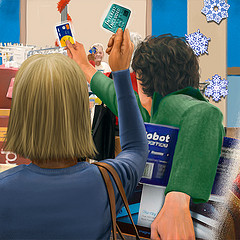Another Study Confirms That Black Friday Isn’t Always The Best Day For Deals Image courtesy of (jaymontgomery)
The Wall Street Journal and Decide.com looked at changes in retail prices for a variety of items one might buy as a gift, from toys to home appliances to jewelry. And excluding the aforementioned bottom-dollar doorbuster deals — which are usually limited to very small inventory and which can vary from one store to another — they found that prices on almost all of these items bottomed out at times other than Black Friday.
For example, the price of a Citizen watch appears to hit its lowest in the middle of winter. In general, prices on watches and jewelry appear to increase steadily through the holiday season, so if you’re buying your loved one a piece of bling in November, you’re going to pay about 10% higher than you would in June.
Meanwhile, prices on KitchenAid stand mixers seem to bottom out during the summer months. The price tag jumps up almost 30% by November, so that Black Friday discount may actually be higher than what you would have paid only a few months earlier. But if you can wait until right before Christmas, the price takes a plunge, as stores begin fretting about having excess inventory of these bulky, pricey items.
Getting back to those doorbuster deals that are the real lure to many Black Friday sales, remember that these are often products that people don’t exactly covet. So while you may be getting a 32″ TV for $80, you may be getting exactly what you pay for — and you woke up at 3 a.m. to do so.
A Consumer Reports study from last year showed that prices on products actually recommended by the magazine varied wildly between November and February, but that Black Friday was rarely the best chance to get a good deal.
Want more consumer news? Visit our parent organization, Consumer Reports, for the latest on scams, recalls, and other consumer issues.


